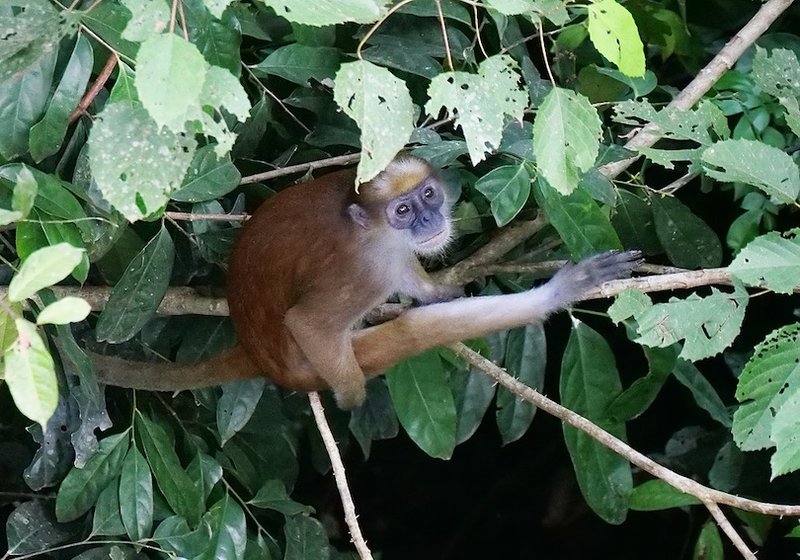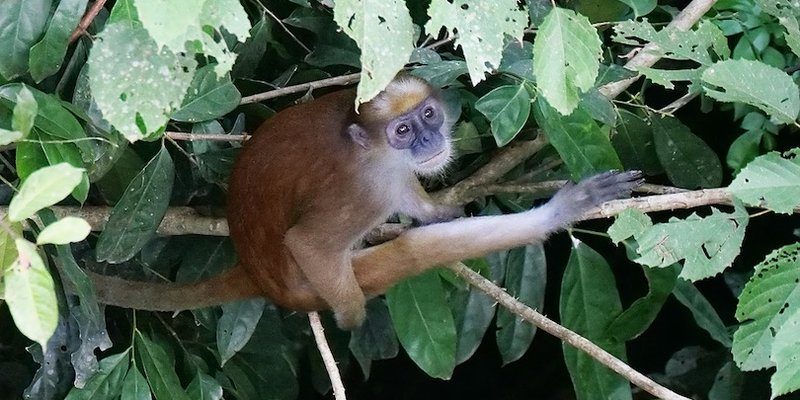
Imagine a creature that seems to embody the essence of the lush, green canopies of African rainforests. That’s the Olive Colobus, a fascinating primate that captivates anyone lucky enough to encounter it. These unique monkeys, with their striking fur and acrobatic abilities, are not just pretty faces; they play a crucial role in their ecosystems. You might be wondering what sets them apart from other monkeys or even what their day-to-day life looks like. Well, let’s dive into the world of the Olive Colobus.
Originating from regions across Central and West Africa, these primates are known for their incredible climbing skills and distinct physiology. Their long limbs and reduced thumbs are adaptations that allow them to navigate the treetops with ease. But there’s so much more beneath the surface, like their social structures and dietary habits, that make them truly unique. Buckle up, as we explore their life from the treetops down to the forest floor!
Physical Characteristics
The Olive Colobus is quite a striking figure in the animal kingdom. Adults typically weigh between 10 to 25 pounds, with males usually being larger than females. Their fur is a beautiful mix of olive green and black, which helps them blend seamlessly into the forest canopy, providing excellent camouflage from predators. This coloration is not just for looks; it’s a vital survival strategy.
Standing about 18 to 25 inches tall, the Olive Colobus has long, slender limbs and a long tail that can be as long as its body. This tail isn’t just for balance or decoration; it aids in their acrobatic moves as they leap between branches. They also have a unique feature—reduced thumbs, which make gripping branches easier but limit their ability to grasp objects like other primates. Curious, right? It’s as if evolution tailored them specifically for life among the trees.
Diet and Feeding Habits
So, what do Olive Colobus monkeys eat? Primarily, they feast on leaves, fruits, and flowers. Their diet is largely folivorous, meaning they consume a lot of leaves, which are nutrient-rich but hard for many creatures to digest. What’s fascinating is their specialized stomach, which helps break down tough plant materials. This adaptation allows them to extract nutrients from food that other animals might disregard.
Eating leaves doesn’t sound all that exciting, but it works for them! They spend a significant portion of their day munching away, often in groups. This social feeding helps them keep an eye out for danger. It’s like having a lunch buddy who also doubles as a lookout! Their preferred diet varies by season, with certain leaves and fruits being more abundant at different times of the year.
Habitat and Range
Olive Colobus monkeys are primarily found in tropical rainforests, particularly in countries like Nigeria, Cameroon, and the Democratic Republic of the Congo. They thrive in dense, humid environments that provide ample cover and food sources. These habitats are crucial for their survival, as they rely on the foliage for both sustenance and safety.
These primates are arboreal, meaning they spend most of their time in trees. They create home ranges that can be up to 50 acres large, where they can swing and leap about freely. The trees are like their personal playgrounds, filled with the resources they need to live their lives. But with habitat loss and deforestation, these ranges have been shrinking, posing significant threats to their populations.
| Characteristic | Details |
| Weight | 10 to 25 pounds |
| Height | 18 to 25 inches |
| Diet | Leaves, fruits, and flowers |
| Habitat | Tropical rainforests in Central and West Africa |
| Social Structure | Live in groups, typically led by a dominant male |
| Lifespan | Up to 20 years in the wild |
| Conservation Status | Vulnerable due to habitat loss |
Social Structure and Behavior
When we think of primate society, we often envision complex social structures filled with hierarchy and interactions—and the Olive Colobus is no exception. They typically live in groups ranging from 10 to 30 individuals, often led by a dominant male. This structure ensures that they can protect each other from predators and nurture their young effectively.
Within their groups, these monkeys engage in a variety of social behaviors. Grooming is a vital part of their interactions, not only for hygiene but also for strengthening bonds. Imagine sitting down with friends, sharing snacks, and catching up—that’s what grooming time is for them! It’s a way to build trust and maintain harmony within the troop.
Interestingly, Olive Colobus monkeys communicate through a series of vocalizations and body language. They use different sounds to express distress, excitement, or alerting others to potential threats. It’s quite a sophisticated communication system for an animal that relies so heavily on their social groups for survival.
Reproduction and Lifespan
Olive Colobus monkeys typically breed once a year, with a gestation period of about 5 to 6 months. After this time, the female usually gives birth to a single infant, although twins can occur occasionally. The mother is primarily responsible for the care of the young, but other troop members often pitch in to help. It’s like having a community babysitter that keeps things fun and safe for the little ones!
Infants are born with a striking coat that slowly changes to the olive coloration as they mature. This change is not just a cosmetic one; it helps them blend in with their surroundings once they start exploring their environment. The social structure of the group plays a significant role in the infant’s upbringing, allowing them to learn essential survival skills from older troop members.
In the wild, Olive Colobus monkeys can live up to 20 years. However, they face numerous challenges that can shorten their lifespan, primarily due to habitat loss and hunting. Conservation efforts are crucial to ensure that these remarkable creatures are around for future generations to admire.
Threats and Conservation Status
The Olive Colobus faces several threats, the most significant being habitat loss due to deforestation and human encroachment. As forests are cleared for agriculture and urban development, these monkeys find their homes shrinking and their food sources dwindling. This loss of habitat not only affects their ability to find food but also increases their vulnerability to predators.
Additionally, hunting and illegal wildlife trade pose serious risks to their populations. Some cultures hunt them for bushmeat, while others capture them for the pet trade. Unfortunately, these practices have led to a decline in their numbers, pushing them towards being classified as vulnerable. You might feel a pang of sadness thinking about these beautiful creatures facing such dangers, but it’s important to know that there are organizations actively working to protect them.
Conservation efforts are underway in many regions, focusing on habitat restoration and community education. By involving local communities in conservation programs, we can raise awareness about the importance of preserving the Olive Colobus and its habitat. After all, protecting our planet’s biodiversity benefits us all.
FAQ
What is the Olive Colobus’s natural habitat like?
The Olive Colobus primarily inhabits tropical rainforests, where they thrive among the trees. These environments provide not only their food sources but also shelter from predators. The dense foliage is crucial for their survival, giving them a safe space to play, eat, and socialize.
How do Olive Colobus monkeys communicate?
These monkeys have a unique communication system that includes various vocalizations and body language. They use different sounds to signal things like danger or excitement, while also employing gestures to convey their feelings. This complex form of communication helps maintain group cohesion and ensures the safety of all members.
Are Olive Colobus monkeys social animals?
Yes, they are highly social creatures that live in groups. This social structure is essential for their survival, as living in a troop offers protection from predators and helps in rearing young ones. Grooming and other activities strengthen their bonds and promote harmony within the group.
What do Olive Colobus monkeys eat?
Their diet primarily consists of leaves, fruits, and flowers. Olive Colobus monkeys are folivorous, meaning they rely heavily on leaves for nourishment. Their specialized stomach helps them digest tough plant materials, allowing them to extract nutrients from the food they consume.
How long do Olive Colobus monkeys live?
In the wild, Olive Colobus monkeys can live for up to 20 years, although various threats can shorten their lifespan. Habitat loss and hunting can impact their survival rates, making conservation efforts vital to ensure their continued existence.
Are Olive Colobus monkeys endangered?
They are classified as vulnerable due to habitat loss and hunting pressures. Conservation initiatives are critical to protecting their populations and natural habitats from destruction, ensuring these beautiful primates continue to thrive in the wild.
What role do Olive Colobus monkeys play in their ecosystem?
These monkeys play a significant ecological role as they help in seed dispersal through their fruit consumption. As they move through their habitat, they contribute to the growth of various plant species. Their presence is crucial for maintaining the health and diversity of their rainforest environments.
How can I help conserve Olive Colobus monkeys?
You can support conservation efforts by donating to wildlife organizations focused on preserving their habitats and raising awareness about the threats they face. Additionally, educating others about the importance of these monkeys and their role in the ecosystem can help promote more significant action toward their conservation.
Where can I see Olive Colobus monkeys in the wild?
Olive Colobus monkeys can be spotted in various tropical rainforests across Central and West Africa. Popular locations include protected areas and national parks, where they live undisturbed. Always remember to be respectful of their habitats and maintain a safe distance while observing these beautiful creatures in their natural environment.
Do Olive Colobus monkeys have predators?
Yes, they do! Natural predators include large birds of prey, leopards, and snakes. In their high canopies, they rely on their agility and social structures to warn each other of impending danger, enabling them to evade threats when possible.

